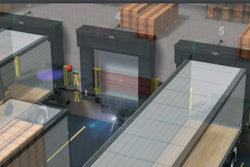WHITEPAPER
Jitter – An Introduction
By Wolfgang Damm,
Product Management Director, Wireless Telecom Group
Abstract: Serial data systems play an increasingly important role whenever
volumes of data are processed or transported. Jitter is a key concern for engin-
eers developing high speed components such as transmitters, receivers and
data channels. Serial high speed communication systems need to operate within
very tight margins; with data provided extremely fast and with an exceptionally
low probability of errors. The challenge for developers is to create high speed
systems at very low cost so products can be competitively marketed.
Discussing the subject matter of jitter completely would exceed the scale of this
paper. Instead, it provides a general introduction to jitter, causes and methods of
jitter measurements, specifically BER and the eye diagram. It will also talk about
examples of standards concerning jitter-tolerance-measurements for serial high
speed components and will take a closer look at the test setup for a serial high
speed PCI express receiver.
What is Jitter?
“Jitter” is a term used in the digital domain, even if causes and resulting effects
are very much of analog nature. Binary information is transmitted as bits in a data
stream of random ones and zeros. In an ideal world these bits would be available
strictly at a certain time and be present for an exactly predetermined period. Fur-
thermore, they would have uniform high and low levels. Unfortunately, the real
world scenario is far from ideal. Designers have to overcome a variety of factors
that influence and the transmitted data signal quality and happen to be a source
of jitter. Jitter is commonly recognized as a high frequency quantity. Jitter-like be-
Wireless Telecom Group Whitepaper: Jitter – An Introduction
www.wtcom.com, Phone: +1-973-386-9696
Page 1 of 7
havior at frequencies below 10 Hz is called “wander” and “drift” at even lower fre-
quencies. Though they are a concern in large-scale synchronous systems,
wander and drift play a negligible role in asynchronous systems because they
are easily tracked by clock data recovery units. Asynchronous systems do utilize
independent reference clocks for transmitters and receivers. The needed clock
frequency in a serial receiver is extracted from the incoming data stream, where
bit transitions are utilized to synchronize the phase locked looped VCO of a clock
data recovery unit (CDR).
Phase & Amplitude Jitter
Timing variations relative to the ideal
transition time are called phase jitter
(Fig. 1 top). Signal level variations
also occur in digital systems; are
called amplitude jitter (Fig. 1
bottom). Because of finite signal
transition times, state level vari-
ations have an impact on the sys-
tems binary state determination. De-
pending on its originating level just
before transition, the slope of the
signal reaches the threshold determ-
ining the actual bit state somewhat
sooner or later. This again has an
effect on the “1” or “0” decision peri-
od available to the system. Since it
is always dependent on the techno-
logy standard, there is no universal
definition of jitter. The International
Telecommunication Union (ITU-I) defines Jitter as:
The short-term variation of the significant instants of a digital signal from
their ideal positions in time.
Jitter can be bounded or unbounded. The former is related in frequency and
magnitude to system events; therefore, bounded jitter is deterministic. This
means disabling the source will stop related bounded jitter too. Bounded jitter al-
ways has a limited magnitude. An example would be Inter Symbol Interference
(ISI): signal transitions cause interference to the neighboring channels, but if the
Wireless Telecom Group Whitepaper: Jitter – An Introduction
www.wtcom.com, Phone: +1-973-386-9696
Page 2 of 7
Figure 1. Phase and amplitude jitter influence
digital systems and can cause bit errors.
originating data lines
are inactive no interfer-
ence occurs. Because
of the finite energy of
originating events, res-
ulting jitter is also finite
and always attenuated.
Unbounded jitter does
not depend on events.
System components or
external influences can
cause it. Most promin-
ent is Random Jitter
(RJ), which is caused
by white noise prevalent
in all active and passive
components. Amplifiers
and line drivers multiply
the energy of noise. By its nature, energy distribution of white noise is Gaussian,
so RJ can be described by the probability density function:
PDF RJ (x) =
Equation 1
where x is the independent value and σ (sigma) the RMS value and μ (mu) the
mean of the distribution. Jitter is defined as deviation from the ideal state, which
means it has positive and negative variations relative to the ideal state. For this
reason μ in jitter analysis is always 0 and can be omitted. Equation 1 indicates
that independently of how large x may become, the probability of certain jitter
causing events may become very small, but it will never reach the x-axis. Due to
its wide frequency spectrum white noise is very difficult to suppress or attenuate
without impacting the actual signal.
System Jitter is caused by a variety of sources, and is either random or determin-
istic. The latter means that its causes are clearly linked to system events. As de-
scribed above, such causes could for example be interference with neighboring
channels during level transitions or insufficiently filtered switching pulses that are
carried over from a switching power supply onto the Vcc network. Table 1
provides a full description of jitter causes.
Wireless Telecom Group Whitepaper: Jitter – An Introduction
www.wtcom.com, Phone: +1-973-386-9696
Page 3 of 7
ISI
Intersymbol
Interference
DCD
Duty Cycle
Distortion
DDJ
Data Dependent
Jitter
PJ
Periodic Jitter
DJ
Deterministic
Jitter
TJ
Total Jitter
RJ
Random Jitter
ECJ
Echo
Jitter
Figure 2. The jitter tree shows types of jitter that can influ-
ence high speed serial data systems.
Jitter Term Description
TJ
Total Jitter
The summation (or convolution) of deterministic and random jitter.
Total jitter is the peak to peak value obtained. TJ = DJ + n × RJ where
n = number of standard deviations corresponding to the required BER.
RJ
Random Jitter
The principal source is Gaussian (white) noise within system compon-
ents. It interacts with the slew rate of signals and produces timing er-
rors at the switching points.
DJ
Deterministic Jitter
Jitter with non-Gaussian probability density function. It is always
bounded in amplitude and with specific causes. Sources are imperfec-
tions of devices, crosstalk, EMI, grounding problems.
PJ
Periodic Jitter
Also called Sinusoidal Jitter due to its sinusoidal form. The source is
usually interference form signals related to the data pattern, ground
bounce or power supply variations.
DDJ
Data dependent Jitter
Consists of Inter Symbol interference (ISI), Duty Cycle distortion
(DCD), and Echo Jitter (ECJ). Timing errors vary with data pattern.
Primary source are component and system bandwidth limitations.
Higher frequency signals have less time to settle than lower frequency
ones. This leads to changes in the start conditions for transitions at dif-
ferent frequencies and produces timing errors dependent on the data
pattern being applied.
ISI
Inter Symbol Interfer-
ence
Inter symbol interference is the most common form of DDJ. It is usually
caused by bandwidth limitations of transmission lines. It affects single
bits surrounded by the bit of the opposite state.
DCD
Duty Cycle Distortion
Duty Cycle Distortion Jitter is caused when certain bit states have dif-
ferent durations. “1” is always longer than “0” or vice versa. Caused by
bias setting, and insufficient VCC supply of a component.
ECJ
Echo Jitter
Echo Jitter is caused by component/line mismatch, it depends on the
data pattern. Line length influence the magnitude of ECJ as well.
Table 1. Jitter types that can influence serial data systems.
Measuring Jitter: Eye Diagram & BER
How to measure high speed data streams and analyze integrity of the data
streams transmitted or received? The prevalent way to conduct this measure-
ment is to determine the Bit Error Rate (BER). A known (pseudo-) random bit
stream is injected into the device under test (DUT). The output of the DUT is
compared against the known data pattern and possible bit errors are counted:
BER = NErr / NBits
Equation 2
Wireless Telecom Group Whitepaper: Jitter – An Introduction
www.wtcom.com, Phone: +1-973-386-9696
Page 4 of 7
where BER is the measured bit error rate, NErr the number of error bits and NBits
the entire number of compared bits. This requires very sophisticated measure-
ment equipment that allows the comparison of each bit’s amplitude and transition
timing and offers capabilities to adjust the signal propagation delay that is en-
tailed with the DUT. The ideal condition serves as reference for jitter related
measurements and is called unit interval (UI):
1 UI = time period of 1 symbol
Transition time and (differential) amplitude influence the outcome of measure-
ments and determine the binary value of a particular bit. Special BERT testers or
oscilloscopes represent the entire data stream through an eye diagram. All
measured bits are displayed at the same time. While the measurement techno-
logy has to be quite sophisticated due to very high data speeds and relatively low
signal levels, the principle of creating an eye diagram is quite simple (Fig. 3). In
Wireless Telecom Group Whitepaper: Jitter – An Introduction
www.wtcom.com, Phone: +1-973-386-9696
Page 5 of 7
A
B
C D
Figure 3. The eye diagram presents the behavior of a very long data stream in a 2UI window.
The whole data stream is folded into the window. The eye diagram allows determination of a
signal’s compliance with requirements defined by the technology standards. Eye diagrams C
and D are stretched in the x-axis by a factor of 2.5 for better resolution.
our example, a bit stream (A) is broken in equal increments: I1 to I11 (B), each the
size of one bit period, which means per definition 1 UI. To allow detailed analysis
of the most important signal parts – the transitions – increments of 2 UI; 0.5 UI
pre-transition, 1UI bit sample and 0.5 UI post-transition are recorded and overlaid
in a 2 UI wide window. The result is the eye diagram as shown in (Fig. 3 C).
The ideal shape of a data bit would match exactly one unit interval (UI) in both,
time and amplitude. Furthermore, under ideal conditions the tolerance margin
would be nearly 1UI (–0.5 UI to +0.5 UI relative to the bit center), to recognize
signal states properly. The
cumulative influence of jitter
sources alters signal amp-
litude and transition timing
which reduces the tolerance
margin significantly. Com-
pliance opening as depicted
in fig. 2 D tells exactly how
much signal transitions and
levels are allowed to vary
from the ideal state before
they cause a bit error.
Technology standards
provide exact descriptions of test setups and measurement margins necessary
for meaningful pass / fail decisions. Table 2 shows an excerpt of these require-
ments for PCIe 2.0, 10Gb Ethernet and SATA II. Some formats allow for more
than 50% margin while others are far stricter. The reader may consult the actual
technology standards for more comprehensive information. Figure 4 shows the
simplified test setup for a PCIe 2.0 jitter compliance test of a serial receiver
(DUT). Purpose of this test setup is to expose the DUT to signal conditions that
are defined by the standard. Once the DUT passes the compliance test, it is en-
sured that the hardware will work well with other components that also passed
the test. A pattern generator provides a known data stream to the DUT. For syn-
chronous systems, both, DUT and pattern generator are clocked with the same
precision clock. Output data of the DUT is compared with the pattern generator
for BER analysis. DUT stressing is achieved by varying the signal’s amplitude,
through different data patterns and generating different data speeds, as seen at
the bottom of the pattern generator. The original data stream is additionally mod-
ulated in different ways. A variable signal generator with a range from 1.5 to 100
MHz generates PJ conditions, another generator, fixed at 33kHz, serves as
spread spectrum clocking simulation. Signal’s transition timing is altered through
a phase generator and a Gaussian white noise generator that injects RJ with
Wireless Telecom Group Whitepaper: Jitter – An Introduction
www.wtcom.com, Phone: +1-973-386-9696
Page 6 of 7
Table 2. Example (excerpt) of measurement require-
ments for PCIe 2.0, 10 GBE, and SATA II
spectral distribution. Finally ISI is generated through special crosstalk lines at the
output of the pattern generator.
Conclusion
This paper introduced different types of jitter: random jitter (RJ), deterministic jit-
ter (DJ) and deterministic jitter’s most important sub-classes. Also discussed
were the influence of jitter on the signal integrity of high-speed serial data sys-
tems and methods of measurement (BER, eye diagram).
Wireless Telecom Group Whitepaper: Jitter – An Introduction
www.wtcom.com, Phone: +1-973-386-9696
Page 7 of 7
Figure 4. Jitter test setup (simplified) for PCIe 2.0 conformance testing
Jitter – An Introduction
Serial data systems play an increasingly important role whenever volumes of data are processed or transported. Jitter is a key concern for engineers developing high speed components such as transmitters, receivers and data channels. Serial high speed communication systems need to operate within very tight margins; with data provided extremely fast and with an exceptionally low probability of errors. The challenge for developers is to create high speed systems at very low cost so products can be competitively marketed.
Latest in Home



















